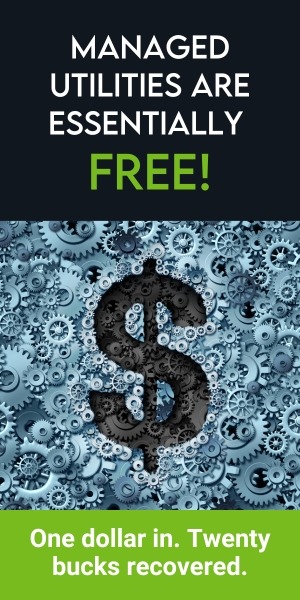The Big Game fervor is mounting across America. Fans make meticulous plans for their game-day feasts – wings, nachos, or perhaps a mix of both – and don colors to root for their favorite team. Living rooms turn into arenas, echoing with excitement for the on-field clashes and off-field commercial battles that capture the nation’s attention.
Yet, beyond the fanfare lies a less conspicuous but more critical battleground: you vs. your utilities. This contest demands a blend of precision, strategy, and teamwork akin to any major sports championship. Here, the competition isn’t just about scoring points; it’s about navigating a complex field of regulations, technology, and efficiency. The goal? To optimize resource use, minimize costs, and achieve sustainable operations.
In this arena, every move counts, and the right strategy can make all the difference. Step into the intricate world of utility management, where the rules of the game change and the rewards for playing smart are significant.
1. Rules and Penalties
Across the U.S., utility management is governed by a variety of rules and regulations designed to promote fairness and conservation. These range from restrictions on certain bill-back methods to mandatory disclosures in tenant leases and energy benchmarking requirements. Compliance is not just a matter of legal obligation; it directly impacts the bottom line.
If your team fails to follow these rules, you may be subject to financial penalties that will push you back and potentially cost you thousands, hundreds, or millions of dollars. For instance, in Boulder, Colorado, the Boulder Building Performance Ordinance mandates comprehensive energy reporting and assessments for commercial, multifamily, and industrial properties with more than 20,000 square feet to:
- Annually report energy data through the ENERGY STAR Portfolio Manager
- Conduct energy assessments every ten years
- Perform retro-commissioning (RC) assessments every ten years, then implement any discovered cost-effective measures within two years of the assessment
- Complete one-time lighting upgrades for energy efficiency
Properties that are not compliant with these requirements are fined $0.0025 per square foot per day with a daily maximum of $1,000.
In early 2022, a small Minnesota-based property management company was penalized for improperly imposing utility surcharges and late fees. The company was then required to provide refunds for the affected tenants with the overall expense costing approximately $50-$60K.
That’s a heck of a penalty for any referee to call–just imagine what the refund amount would have been if this non-compliant company was managing hundreds of properties instead of four.
2. Reliable, Experienced Teams
Managing utility bills without automation or support can be as time-consuming as a three-day-long drive in football. It involves more than just processing; you have to hunt down missing bills, audit invoices, address issues with providers, and manage resident billing. While this might be manageable with a small number of accounts, getting utility management right normally requires a full team effort.
A successful utility management team is like a well-coordinated football squad. It needs skilled players in diverse roles: receivers to efficiently gather bills, quarterbacks to accurately allocate charges to residents and tenants, running backs to identify and address gaps, and a strong legal defense to maintain compliance and safeguard the operation. Each member plays a critical role, and their coordinated effort ensures a smooth and error-free process. The synergy ensures every play leads to progress.
3. The Evolution of Gear
Since football’s origin in the late 1800s, gridiron gear has dramatically changed in order to increase athlete efficiency and protection, evolving from rugby-inspired sweaters and leather helmets to jerseys, pads, padded helmets, and cleats. Much like how football gear has transformed – the technology in utilities management has also undergone a significant evolution.
In our over two decades of experience in the field, we’ve witnessed and contributed to this remarkable change. Managed Utilities are unbelievably lucrative for property owners and managers. Our Utility PropTech Ecosystem, for example, processed over 20 million bills and saved clients over $104 million in 2023 alone.
We’ve streamlined bill payment procedures to minimize late fees and revamped bill-back systems for improved cost recovery. Our utility management platforms are now capable of real-time tracking of both utility usage and ESG data. Additionally, we’ve introduced innovative monitoring tools for cost-effective waste management. These advancements represent just a fraction of the continuous improvements we’re making to simplify and optimize every facet of utility management.
If you’re still relying on old gear or outdated methods, it’s time to consider an upgrade.
4. A Game of Strategy
Utility management requires a well-thought-out game plan to succeed. So, how can you craft a strategy that scores touchdowns?
Learn from Industry All-Stars
Consider the property management sector’s top players – Greystar, Bozzuto, American Homes, Cardinal Group, Phillips Edison, etc. These organizations consistently score big in utility management. Research their methods: Are they handling utilities internally, utilizing specialized apps, or outsourcing entirely? Investigate how they’ve reduced utility costs and enhanced efficiency in their properties.
Don’t Bench the Data
If your company has utility data available, put it to work. Monitor utility use and costs regularly to spot trends, inefficiencies, and anomalies. Benchmark your properties against similar ones in your portfolio or market. If you lack this data, tap into online resources such as market research, benchmarking statistics, and educational articles.
Engage with Your Players
Finally, listen to the feedback from those on the ground: your team, tenants, and stakeholders. Understand their perspective on your utility management and efficiency objectives. What improvements do they suggest? What are their expectations? Incorporate this valuable feedback to fine-tune your approach.
Leverage Expertise from Utility Managers
Consult with experts who manage utilities full-time. Their deep understanding of the utility market and specific services can guide you in formulating an effective strategy for your portfolio.
5. A World That’s Watching
History, the future, your customers, your investors, and residents are in the stands right now, watching your game and judging your plays. To emerge victorious in this scenario, adherence to the rules is just the starting point. Team up with a solid, skilled crew who understand the nuances of the game. Continuously upgrade your technological arsenal to stay ahead. Enter the field armed with a robust and adaptable game plan. With this approach, you’re not just playing to win; you’re setting a standard for excellence in utility management.







